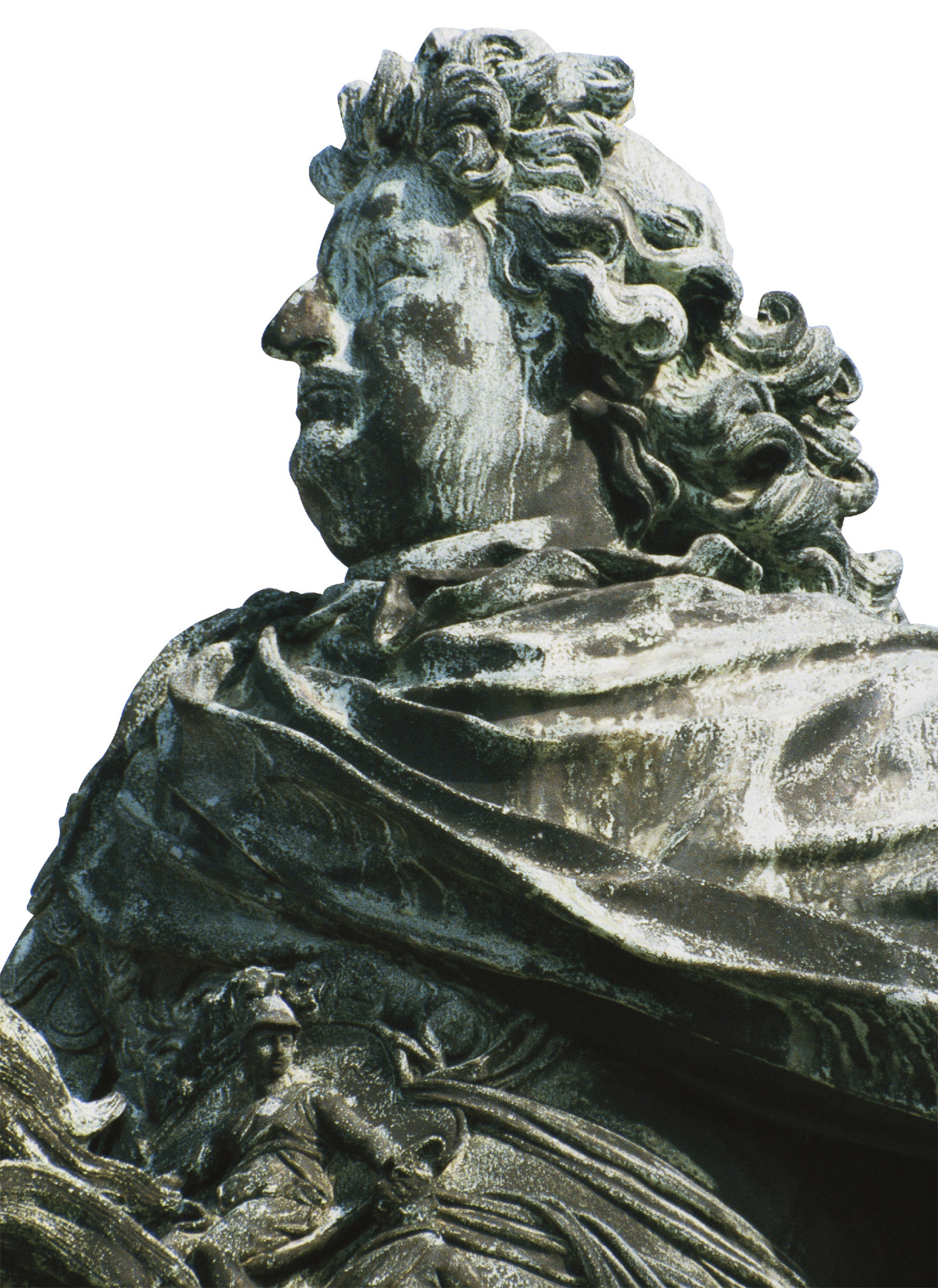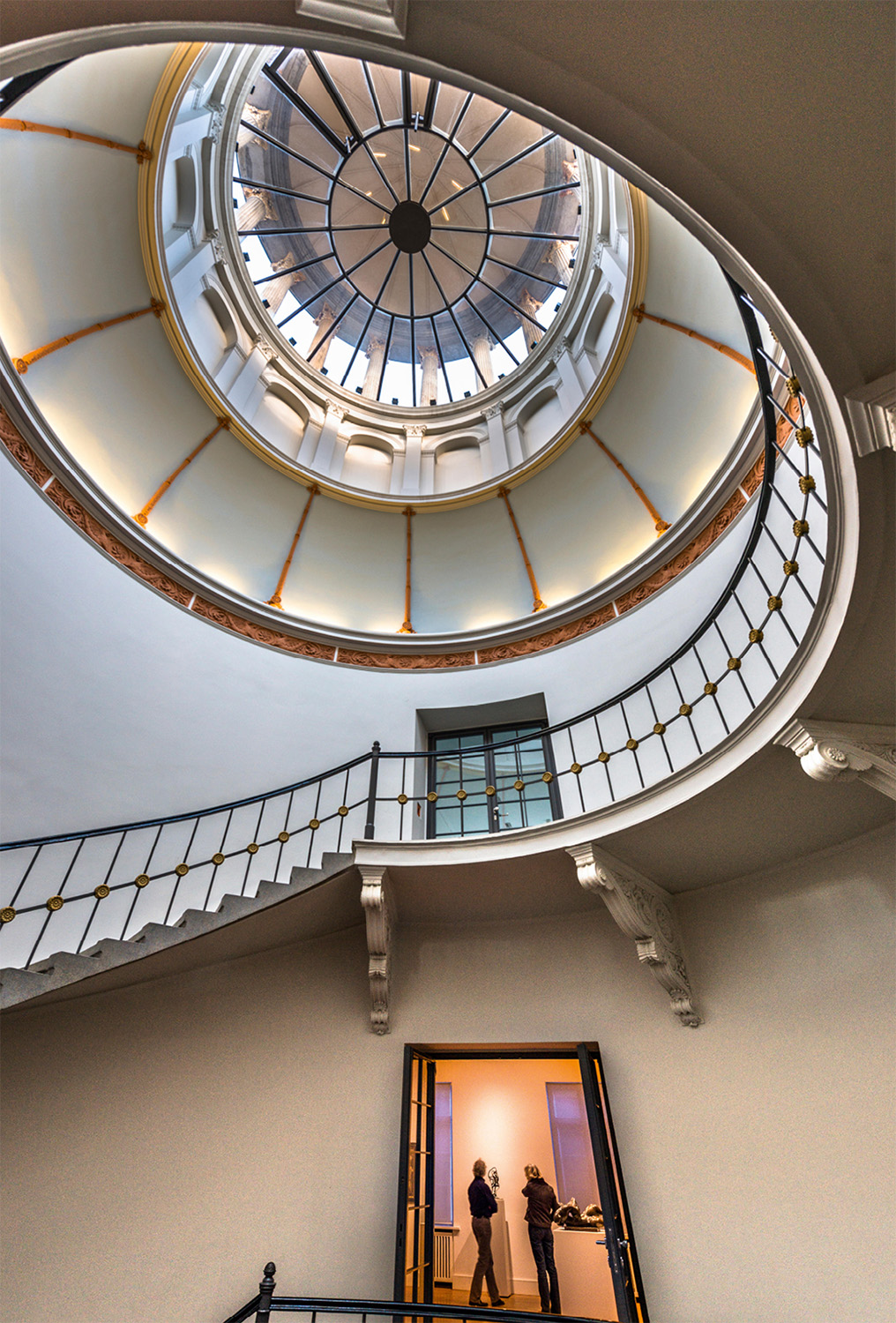
t Cherubs striking playful poses in royal Schlosspark

t Cherubs striking playful poses in royal Schlosspark
The extensive palace park that surrounds Schloss Charlotten-burg, crisscrossed with tidy gravel paths, is a favourite place for Berliners to stroll at the weekend. The park is largely the result of reconstruction work carried out after World War II, when 18th-century prints were used to help recreate the varied layout of the original grounds.
Immediately behind Schloss Charlottenburg is a French-style Baroque garden, made to a strict geometrical design with a vibrant patchwork of flowerbeds, carefully trimmed shrubs and ornate fountains. Further away from the palace, beyond the curved carp lake, is a less formal English-style landscaped park, originally laid out in the 1820s under the direction of the renowned royal gardener, Peter Joseph Lenné. The lakes and waterways of the park are the habitat of various waterfowl, including herons. A bike path runs along the Spree from the palace park to the Tiergarten and beyond.
This charming Neo-Classical pavilion, with its clean lines and first-floor balcony, was built for Friedrich Wilhelm III and his second wife, Princess Auguste von Liegnitz. During a visit to Naples, the king was so impressed by the Villa Reale del Chiamonte that he commissioned Karl Friedrich Schinkel to build him something similar. The pavilion was finished for the king’s birthday on 3 August 1825. Schinkel designed a two-storey structure with a central staircase and ranged the rooms around it in perfect symmetry. Pillared galleries on the first floor added variety to the eastern and western elevations. A cast- iron balcony runs around the entire structure. Like many other Schloss Charlottenburg buildings, the pavilion burned down completely in World War II and was rebuilt in 1960. The display inside the pavilion reveals the original splendour of the aristocratic interiors, enhanced with pictures and sculptures of the period. The prize picture is a renowned panorama of Berlin dated 1834, painted by Eduard Gärtner from the roof of the Friedrichswerdersche Kirche. You can also admire paintings by Schinkel, not only a great architect but also a fine painter of fabulous architectural fantasies.
Experience Around Schloss Charlottenburg
|
EAT Brauhaus Lemke am Schloss Set right beside the Schloss Charlottenburg, this classic brewhouse makes a convenient spot for post-tour sustenance. The interior is as reassuringly traditional as the menu, which features home-brewed beer and filling, meat-heavy German food. B4 ⌂ Luisenplatz # noon–midnight daily ∑ lemke.berlin ¡¡¡ |
Queen Luise, the beloved first wife of Friedrich Wilhelm III, was laid to rest in this modest, dignified building, set among the trees in Schlosspark. The mausoleum was designed by Karl Friedrich Schinkel, in the style of a Doric portico-fronted temple.
In the original design, the queen’s sarcophagus was housed in the crypt while the tombstone (a cenotaph sculpted by Christian Daniel Rauch) stood in the centre of the mausoleum. After the death of Friedrich Wilhelm in 1840, the mausoleum was refurbished, an apse added and the queen’s tomb moved to one side, leaving room for her husband’s tomb, also designed by Rauch. The second wife of the king, Princess Auguste von Liegnitz, was also buried in the crypt of the mausoleum.
Between 1890 and 1894, the tombs of Kaiser Wilhelm I and his wife, Auguste von Sachsen-Weimar, were added to the crypt. Both monuments are the work of Erdmann Encke.
The Monument to the Great Elector (Friedrich Wilhelm) is the finest in Berlin and was paid for by his son, Elector Friedrich III (later King Friedrich I). Designed by Andreas Schlüter to be cast in one piece, the statue was completed in 1703, and erected near the former Berlin palace, by Lange Brücke (now called Rathausbrücke). The statue was moved to safety in World War II, but ironically, on the return journey, the barge transporting the monument sank in the port of Tegel.
In 1949 the statue was retrieved intact from the water and erected here on a copy of the base. The original base finally ended up in the Bode-Museum topped with a replica of the statue.
The statue portrays the Great Elector as a warrior on horseback, triumphant over the figures of prisoners of war around the base. The base itself is decorated with patriotic reliefs of allegorical scenes. One scene depicts the kingdom surrounded by figures representing Peace, History and the Spree river; another shows it protected by embodiments of Bravery, Faith and Strength (represented by the figure of Hercules).
Founded by Friedrich Wilhelm III in 1819, the Berlin Replica Workshop produces original-sized replicas from items in Berlin museums and other collections, and also repairs damaged sculptures. Visitors are welcome to this modest brick building west of Schloss Charlottenburg and can purchase items on the spot or choose from cata-logues to have them made to order and shipped home. Sculptures are generally copied in white plaster or painted true to the original. Most moulds originate from the Middle Ages, the Renaissance and the 19th century.
Experience Around Schloss Charlottenburg

The Elector Friedrich Wilhelm was one of the most famous rulers of the Hohenzollern dynasty. He inherited the position of ruler of Brandenburg-Prussia in 1640, and one of his first duties was to rebuild the region after the devastation of the Thirty Years’ War (1618–48). In 1660 he wrested the Duchy of Prussia territory from Poland. During the course of his reign, Berlin became a powerful city, and rich families from all over Europe – fleeing persecution in their own land – chose to settle here.
This museum provides a unique opportunity to become acquainted with the work of Käthe Kollwitz (1867–1945). Born in Königsberg, the artist settled in Berlin, where she married a doctor who worked in Prenzlauer Berg, a working-class district. Her drawings and sculptures portrayed the social problems of the poor, as well as human tragedy and suffering. She frequently took up the theme of motherhood and war after losing a son and grandson in World Wars I and II.
The museum exhibits her work, including sculptures, posters and drawings, as well as letters and photographs.
Most of the historic villas and buildings that once graced Schlossstrasse no longer exist. However, careful restoration of a few villas enables the visitor to get a feel for what the atmosphere must have been like at the end of the 19th century. It is worth taking a stroll down Schlossstrasse to look at the renovated villas, especially No. 67, which was built in 1873 in a Neo-Classical style to a design by Georg Töbelmann. If you continue the walk down nearby Schustehrusstrasse, you’ll see an interesting school building at No. 39–43. Just up the road at No. 55 is the fine Villa Oppenheim, home of the Charlottenburg-Wilmersdorf Museum, open to the public except on Mondays.
The two 1850s pavilions on either side of Schlossstrasse were intended as officers’ barracks for the King’s Guard du Corps. Adjoining the eastern one is the Marstall, or stable block, and in this can be found the Museum Scharf-Gerstenberg. The museum presents paintings, sculptures, works on paper and even films by Surrealist and associated artists such as Dalí, Magritte, Max Ernst, Paul Klee and Jean Dubuffet, and also older works by Goya, Piranesi and Redon. More than 250 objects are presented over three floors, explaining the history of surreal art, with pieces from almost all the leading Surrealists.

t Spiral staircase below the cupola of the Museum Scharf-Gerstenberg
The pavilions on either side of Schlossstrasse were inspired by a design by King Friedrich Wilhelm IV.
This small church dates back to 1716, but its original Baroque styling was removed in rebuilding undertaken by Karl Friedrich Schinkel in the 1820s, when the church was renamed in memory of Queen Luise (1776–1810).
The shape of the church is based on a traditional Greek cross, with a tower at the front. The interior fixtures and fittings are not the originals, and the elegant stained-glass windows were made in 1956.

t A formal green avenue leading up to the Belvedere
The Belvedere is a summer house in the Schlosspark which served as a tea pavilion for Friedrich Wilhelm II and, in times of war, as a watchtower. It dates from 1788 and was designed by Carl Gotthard Langhans. The architect mixed Baroque and Neo-Classical elements, giving the building an oval central structure with four straight-sided annexes. The building is crowned by a low dome topped with a sculpture of three cherubs supporting a basket of flowers.
Though the Belvedere was ruined during World War II, the summer house was reconstructed between 1956 and 1960 and adapted to serve as an exhibition space. The exhibition is a large collection of exquisite porcelain from the Berlin Königliche Porzellan-Manufaktur (Royal Porcelain Workshop), which has pieces from the Rococo period up to late Biedermeier, including some outstanding individual items.
Heinz Berggruen assembled this tasteful collection of art dating from the late 19th and first half of the 20th century. Born and educated in Berlin, he emigrated to the US in 1936, spent most of his later life in Paris, but later entrusted his collection to the city of his birth. The museum opened in what was once the west pavilion of the barracks using space freed up by moving the Antiken-sammlung to Museumsinsel. The exhibition halls were modified according to the designs of Hilmer and Sattler, who also designed the layout of the Gemäldegalerie. The Museum Berggruen is particularly well known for its large collection of quality paintings, drawings and gouaches by Pablo Picasso.The collection begins with a drawing from his student days in 1897 and ends with works he painted in 1972, one year before his death.
In addition to these, the museum displays more than 60 works by Swiss artist Paul Klee and more than 20 works by Henri Matisse. The museum also houses paintings by other major artists, such as Georges Braque and Paul Cézanne. The collection is supplemented by some excellent sculptures, particularly those of Henri Laurens and Alberto Giacometti.
This small but interesting museum, set in a late Neo-Classical building, houses a collection of decorative arts amassed by Karl H Bröhan, who from 1966 collected works of art from the Art Nouveau (Jugendstil or Secessionist) and Art Deco periods. The paintings of the artists particularly connected with the Berlin Secessionist movement, such as Karl Hagemeister and Hans Baluschek, are especially well represented. Alongside the paintings there are fine examples of arts and crafts in other media: furniture, ceramics, silverwork and textiles. There is glasswork by Émile Gallé and porcelain from some of the finest European manufacturers.